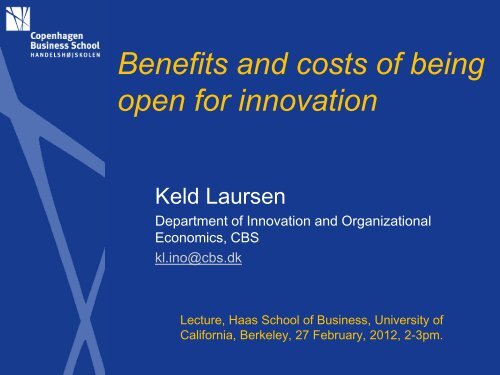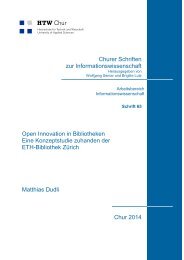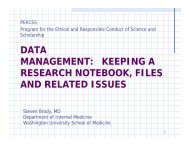Benefits and costs of being open for innovation
Benefits and costs of being open for innovation
Benefits and costs of being open for innovation
Create successful ePaper yourself
Turn your PDF publications into a flip-book with our unique Google optimized e-Paper software.
<strong>Benefits</strong> <strong>and</strong> <strong>costs</strong> <strong>of</strong> <strong>being</strong><br />
<strong>open</strong> <strong>for</strong> <strong>innovation</strong><br />
Keld Laursen<br />
Department <strong>of</strong> Innovation <strong>and</strong> Organizational<br />
Economics, CBS<br />
kl.ino@cbs.dk<br />
Lecture, Haas School <strong>of</strong> Business, University <strong>of</strong><br />
Cali<strong>for</strong>nia, Berkeley, 27 February, 2012, 2-3pm.
About me<br />
• MSc, 1994, SPRU, University <strong>of</strong> Sussex, UK.<br />
• PhD, 1998, Aalborg University, Denmark.<br />
• Pr<strong>of</strong>essor at C<strong>open</strong>hagen Business School (CBS).<br />
• Have been working on Open Innovation Issues<br />
since 2002/2003 (a very early follower with Ammon<br />
Salter! ).<br />
• I’m the co-author <strong>of</strong> the most cited academic paper<br />
on Open Innovation (Laursen & Salter, SMJ<br />
2006)—but not the most cited publication! (which<br />
is, btw, a book…).<br />
• Is the director a research group at CBS:<br />
C<strong>open</strong>hagen Research Unit on <strong>open</strong> Innovation<br />
Search & Entrepreneurship (CRUISE), funded by<br />
CBS <strong>and</strong> the Danish Research Council <strong>for</strong><br />
Independent Research: Social Sciences.
About our group<br />
Mark Lorenzen<br />
Jens Frøslev Christensen.<br />
Lars Bo Jeppesen (just left <strong>for</strong><br />
Bocconi in Milan)<br />
Jing Chen (joined us from<br />
Florida International U.).<br />
Thomas Rønde (joined us from University <strong>of</strong> C<strong>open</strong>hagen).<br />
Toke Reichstein (joined us from Imperial<br />
College London).<br />
Valentina Tartari<br />
(to join us in September<br />
from Imperial College London).<br />
Serden Özcan<br />
Christoph Grimpe (joined us from<br />
ZEW, Mannheim).<br />
Marion Pötz (joined us from<br />
the University <strong>of</strong> Vienna).<br />
Christina Vaarst Andersen (just<br />
joined from Roskilde University)<br />
Christoph Hienerth (joined us<br />
from the University <strong>of</strong> Vienna).
The geographical context<br />
• 5.5 mill.<br />
Inhabitants.<br />
• A diversified<br />
economy.<br />
• High labor<br />
mobility between<br />
firms<br />
• Manufacturing<br />
strengths:<br />
• Pharmaceuticals/<br />
biotech<br />
• Specialized<br />
mechanical<br />
engineering<br />
• Service strengths:<br />
• Shipping<br />
• Strong sciencebase
Open Innovation: What is<br />
new?<br />
• The idea <strong>of</strong> the importance <strong>of</strong> “distributed”<br />
or “<strong>open</strong>” <strong>innovation</strong> processes is not new.<br />
• What is new is (my subjective view!):<br />
• That there are drivers (stronger labor mobility, “s<strong>of</strong>tware<br />
movements”, increased division <strong>of</strong> labor & venture<br />
capital; more on next slide) that accelerate the process at<br />
this point in time (Chesbrough, 2003).<br />
• That a firm should think about its degree <strong>of</strong> <strong>open</strong>ness not<br />
only to specific external sources <strong>of</strong> <strong>innovation</strong>, but has to<br />
manage a portfolio <strong>of</strong> external sources (Chesbrough,<br />
2003, Laursen & Salter, 2006, SMJ).<br />
Henry Chesbrough
What changed? New Division<br />
<strong>of</strong> Labor related to Innovation<br />
• Erosion factors according Chesbrough:<br />
• Increasing mobility <strong>of</strong> trained engineers <strong>and</strong><br />
scientists.<br />
• Increasing importance <strong>of</strong> venture capital (at least in<br />
the US).<br />
• Increased “quality” <strong>of</strong> university research.<br />
• Increased rivalry between companies in their product<br />
markets (EU-market liberalization; competition<br />
policy).<br />
• Greater dissemination <strong>of</strong> knowledge throughout the<br />
world, facilitated by in<strong>for</strong>mation <strong>and</strong> communication<br />
technology (including the rise <strong>of</strong> markets <strong>for</strong><br />
technology).
Open Innovation: <strong>Benefits</strong> <strong>and</strong><br />
Costs<br />
• What advantages does <strong>open</strong> <strong>innovation</strong> have?<br />
• Access to a variety <strong>of</strong> knowledge sources that cannot possibly<br />
be available in-house (or would be prohibitively expensive to<br />
possess). In particular:<br />
• Context specific knowledge from users (f.i. direct collaboration with<br />
users or through internet communities).<br />
• Knowledge produced in other specialized firms (obtained, <strong>for</strong><br />
instance through collaboration, labor mobility <strong>of</strong> knowledge personnel<br />
or through licensing-in).<br />
• Problem-solutions from people with a different perspective on the<br />
issue (f.i. InnoCentive; cf. Jeppesen/Lakhani work).<br />
• Access to the science-base (<strong>for</strong>mal or in<strong>for</strong>mal collaboration with<br />
universities).<br />
• However, despite the advantages, <strong>open</strong> <strong>innovation</strong><br />
has significant <strong>costs</strong> (Laursen <strong>and</strong> Salter, 2006).<br />
Ammon Salter
Examples <strong>of</strong> trade-<strong>of</strong>fs in <strong>open</strong><br />
<strong>innovation</strong> processes<br />
Generic <strong>costs</strong><br />
<strong>and</strong> benefits<br />
<strong>Benefits</strong> <strong>of</strong> <strong>open</strong> <strong>innovation</strong><br />
- Variety <strong>of</strong> inputs in the search <strong>and</strong> knowledge production<br />
process<br />
Costs <strong>of</strong> <strong>open</strong> <strong>innovation</strong><br />
- High coordination <strong>costs</strong>, given cognitive <strong>and</strong> resource<br />
limitations <strong>of</strong> agents (absorptive capacity). Appropriabiltity<br />
Open <strong>innovation</strong><br />
mechanism<br />
search using several<br />
sources <strong>of</strong> <strong>innovation</strong><br />
2. Working with users<br />
<strong>of</strong> <strong>innovation</strong>s<br />
3. Innovations around a<br />
technological plat<strong>for</strong>m:<br />
Attracting unpaid<br />
contributors<br />
problems. 1Open <strong>innovation</strong><br />
Specific benefits Specific <strong>costs</strong><br />
- External sources <strong>of</strong> <strong>innovation</strong><br />
increase the breadth <strong>of</strong> search<br />
-Investment in appropriability<br />
mechanisms (partly) prevents<br />
copying.<br />
- Obtain knowledge that can<br />
only be obtained through the use<br />
<strong>of</strong> a product.<br />
- Contributors supply free<br />
content to a plat<strong>for</strong>m technology.<br />
4. In-licensing - Complementarities between inlicensed<br />
<strong>and</strong> own technologies.<br />
5. Labor mobility - Labor mobility can ensure an<br />
inflow <strong>of</strong> new knowledge to the<br />
firm.<br />
- Disclosure, imitation<br />
- Very strong emphasis on<br />
appropriability hinders<br />
collaboration.<br />
- Since users are <strong>of</strong>ten<br />
conservative, investments in<br />
identifying lead users is needed.<br />
- Costs <strong>of</strong> facilitating contributor<br />
development to plat<strong>for</strong>m via<br />
improvement <strong>of</strong> tools <strong>and</strong><br />
infrastructure<br />
- Necessary investments in<br />
absorptive capacity, <strong>costs</strong><br />
related to cognition, opportunity<br />
<strong>costs</strong> in alternative R&D<br />
investment.<br />
- Competitive advantage may be<br />
undermined by employees<br />
leaving <strong>for</strong> competitors.
Two examples <strong>of</strong> benefits <strong>and</strong> <strong>costs</strong><br />
• Open Innovation practices can potentially<br />
provide the vital knowledge <strong>for</strong> future products<br />
<strong>and</strong> services, but require (expensive) attention<br />
to internal organizational practices.<br />
• Inward mobility <strong>of</strong> university researchers into<br />
industrial firms has great potential, but there are<br />
non-trivial <strong>costs</strong> associated with integrating<br />
these researchers in the focal firm.
Example #1: Internal<br />
organizational practices
Changing Business Models<br />
P&G established connect + develop in order to react to the <strong>open</strong><br />
<strong>innovation</strong> challenge.<br />
Objective: 50% <strong>of</strong> Innovation<br />
should be developed outside<br />
<strong>of</strong> own R&D labs<br />
(CEO Alan G. Lafley)
-- Chris Thoen, Manager,<br />
P&Gs <strong>open</strong> <strong>innovation</strong>initiative.<br />
IM: So what is your system <strong>of</strong> internal<br />
responsiveness?<br />
CT: This is still a journey, even <strong>for</strong> us. We<br />
are further along than some companies. And<br />
every step you take you learn more. We see<br />
it as very fluid. Two things that are important<br />
in setting up an <strong>innovation</strong> system that is<br />
effective <strong>and</strong> works well are that even be<strong>for</strong>e<br />
looking externally you need good<br />
<strong>innovation</strong> processes internally. Open<br />
<strong>innovation</strong> will not make you a good<br />
innovator if you don’t have the processes to<br />
deal with <strong>innovation</strong> – you will only overload.<br />
If the processes are not smooth <strong>and</strong> well<br />
oiled, don’t focus on <strong>open</strong> <strong>innovation</strong>.<br />
http://www.<strong>innovation</strong>management.se/2011/04/21/procter-<strong>and</strong>-gambles-chris-thoen-on-<strong>open</strong>-<strong>innovation</strong>/
Firm-internal organization<br />
• Burns <strong>and</strong> Stalker (1961) distinguish the<br />
“mechanistic” from the “organic”<br />
organization.<br />
• An organic organization implies that activities<br />
are organized in a flexible, decentralized,<br />
in<strong>for</strong>mal <strong>and</strong> highly integrated organizational<br />
structure.<br />
• Burns <strong>and</strong> Stalker concluded that the organic<br />
<strong>for</strong>m is conducive to <strong>innovation</strong>.<br />
• However, the idea <strong>of</strong> the “organic” <strong>for</strong>m is not<br />
overly precise.<br />
• And the relation to <strong>open</strong> <strong>innovation</strong> is not clear.
Firm-internal organization<br />
• Modern management research is in<br />
agreement with Burns <strong>and</strong> Stalker:<br />
Organization matters:<br />
• Innovation is uncertain activity.<br />
• It is difficult <strong>for</strong> management to take correct decisions<br />
because the management do not have the appropriate<br />
in<strong>for</strong>mation on which to base decisions.<br />
• The knowledge needed to produce <strong>and</strong> <strong>innovation</strong><br />
resides in many places in the organization (marketing,<br />
production, R&D, accounting).
Firm-internal organization<br />
• So work practices <strong>for</strong> Delegation<br />
<strong>and</strong> Lateral communication within<br />
the firm is needed.<br />
• However, employees also need to<br />
be motivated <strong>and</strong> they need to be<br />
Compensated <strong>for</strong> the delegation <strong>of</strong><br />
responsibility.
Firm-internal organization<br />
• Research indentifies four sets <strong>of</strong><br />
organizational practices are<br />
conducive to <strong>innovation</strong> output:<br />
• Delegation <strong>of</strong> responsibility<br />
• Practices that furthers (lateral) communication<br />
• Practices involving knowledge incentives<br />
• (Recruitment <strong>and</strong> training)<br />
• There may also be<br />
complementarities between these<br />
practices (when increasing the use<br />
<strong>of</strong> one practice increases the<br />
return <strong>of</strong> the other). Example.
The Foss, Laursen & Pedersenmodel,<br />
2011 Organization Science<br />
Interaction with<br />
costumers<br />
H 1<br />
+<br />
H 2<br />
+<br />
Delegation <strong>of</strong><br />
responsibility<br />
H 3<br />
+<br />
H 4<br />
+<br />
Knowledge<br />
incentives<br />
Internal<br />
Communication<br />
H 5<br />
+<br />
H 6<br />
+<br />
Innovation<br />
per<strong>for</strong>mance
Foss, Laursen & Pedersen<br />
• 2001: 1000 largest Danish firms (in<br />
2000) received a questionnaire (DK<br />
context: LM firms).<br />
• After two reminders, a total <strong>of</strong> 207 firms<br />
responded to the survey, providing a<br />
response rate <strong>of</strong> 21 percent.<br />
• 169 responses were usable <strong>for</strong> statistical<br />
analysis. Had an average <strong>of</strong> 1,811<br />
employees (down to 350 employees).<br />
• Respondent: CEO (in some cases the<br />
HRM-manager or other managers have<br />
responded).<br />
• Structural equation modeling.
The Foss, Laursen & Pedersenmodel,<br />
2011 Organization science<br />
Interaction with<br />
costumers<br />
H 1<br />
+<br />
H 2<br />
+<br />
Delegation <strong>of</strong><br />
responsibility<br />
Knowledge<br />
incentives<br />
Internal<br />
Communication<br />
• Conclusion: The relationship is fully<br />
mediated by internal organizational<br />
practices (that imposes <strong>costs</strong>).<br />
H 3<br />
+<br />
H 4<br />
+<br />
H 5<br />
+<br />
H 6<br />
+<br />
Innovation<br />
per<strong>for</strong>mance
Some firms are aware <strong>of</strong> the importance <strong>of</strong><br />
internal organization when sourcing<br />
external knowledge…<br />
• Dougherty (2001, p. 625) cites a marketing manager at<br />
“Texco”:<br />
• I came to this business seven years ago. It had a traditional<br />
organization with director <strong>of</strong> development [technology] <strong>and</strong> a bunch<br />
<strong>of</strong> engineers, <strong>and</strong> a marketing manager <strong>and</strong> salesmen. The<br />
salesmen would go <strong>and</strong> find customers <strong>and</strong> get a quote on a<br />
product, <strong>and</strong> bring it back <strong>and</strong> drop it in a box, <strong>and</strong> the engineers<br />
would pick them up <strong>and</strong> do them. The salesman would go back to<br />
the customer <strong>and</strong> show it to them <strong>and</strong> say “is this OK?” We were<br />
doing hundreds <strong>of</strong> these costings, <strong>and</strong> very few <strong>of</strong> them would get to<br />
the sample stage, <strong>and</strong> <strong>of</strong> those, very few succeeded. Our hit rate<br />
was very low…. Everything the engineers worked on was screened<br />
through the sales people, <strong>and</strong> they never heard the voice <strong>of</strong> the<br />
customer… Now the new ventures team develops new markets <strong>and</strong><br />
<strong>innovation</strong>s, <strong>and</strong> pulls in people from across the organization…<br />
[Consider] the weaving, dyeing, <strong>and</strong> finishing plants. We help them<br />
underst<strong>and</strong> the needs <strong>and</strong> the wants, do the QFDs [quality function<br />
deployments], have the manufacturing people help with the QFDs,<br />
<strong>and</strong> the development engineers take the process engineers to<br />
several customers.
Example #2: Inward mobility <strong>of</strong><br />
university researchers
Inward mobility <strong>of</strong> university<br />
researchers<br />
• Starting point: “One erosion factor that has led to<br />
the demise <strong>of</strong> the Closed Paradigm is the<br />
increasing availability <strong>and</strong> mobility <strong>of</strong> skilled<br />
workers. This factor has many causes.[…]. The<br />
supply <strong>of</strong> well trained, knowledgeable people<br />
exp<strong>and</strong>ed tremendously during the post-war<br />
period. This represented a large increase in the<br />
raw material able to produce useful knowledge.”<br />
(Chesbrough, 2003, p.34)<br />
Henry Chesbrough
Inward mobility <strong>of</strong> university<br />
researchers<br />
• On the New Role <strong>of</strong> Research:<br />
• “Beyond Knowledge Generation to Connection Open<br />
Innovation thinking changes the role <strong>of</strong> the research<br />
function. It exp<strong>and</strong>s the role <strong>of</strong> internal researchers to<br />
include not just knowledge generation, but also<br />
Henry Chesbrough<br />
knowledge brokering. Previously, researchers simply<br />
added to the knowledge sitting in the silos. Today,<br />
they are also charged with moving knowledge into <strong>and</strong><br />
out <strong>of</strong> the silos. In this new role, knowledge located<br />
from outside may be just as useful as knowledge<br />
created from within — <strong>and</strong> it should be similarly<br />
rewarded.” (Chesbrough, 2003).
Inward mobility <strong>of</strong> university<br />
researchers<br />
• Open <strong>innovation</strong> as a way <strong>of</strong> exploiting the division <strong>of</strong><br />
labor:<br />
• “Merck accounts <strong>for</strong> about 1% <strong>of</strong> the biomedical research in the<br />
world. To tap into the remaining 99 percent, we must actively<br />
reach out to universities, research institutions <strong>and</strong> companies<br />
worldwide to bring the best <strong>of</strong> technology <strong>and</strong> potential products<br />
into Merck. The cascade <strong>of</strong> knowledge flowing from<br />
biotechnology <strong>and</strong> the unraveling <strong>of</strong> the human genome- to<br />
name only two recent developments - is far too complex <strong>for</strong> any<br />
one company to h<strong>and</strong>le alone.” (citation from Chesbrough,<br />
2003, p. 53).<br />
• One was <strong>of</strong> “tapping into research” is through labor<br />
mobility from universities.<br />
• In a recent research paper we look at how the inflow<br />
<strong>of</strong> researchers from other organizations into <strong>for</strong>-pr<strong>of</strong>it,<br />
private firms affect the innovative outcome: New<br />
graduates, from other firms <strong>and</strong> from (public)<br />
universities (benchmark: “Stayers”).
Misaligned incentives<br />
• Scientific <strong>and</strong> technological the search <strong>for</strong> knowledge is<br />
fundamentally different because (Dasguta & David, 1994),<br />
due to differences in:<br />
• The nature <strong>of</strong> the goals accepted as legitimate within the two<br />
communities <strong>of</strong> researchers.<br />
• The norms <strong>of</strong> behavior especially in regard to the disclosure <strong>of</strong><br />
knowledge.<br />
• The reward systems.<br />
• Academically trained scientists tend to have a strong<br />
“taste <strong>for</strong> science” — preferences <strong>for</strong> basic research, <strong>for</strong><br />
the freedom in choosing research projects, <strong>and</strong> <strong>for</strong><br />
disclosure <strong>of</strong> research results (Stern, 2004; Roach <strong>and</strong><br />
Sauermann, 2010).<br />
• Industry <strong>of</strong>ten need scientific insights, but firms do not<br />
directly gain from contributing to important scientific<br />
questions (Gittelman <strong>and</strong> Kogut, 2003; Lacetera, 2009).<br />
• These observations suggest that employing university<br />
scientists in industrial settings is challenging (<strong>and</strong><br />
expensive!) <strong>for</strong> pr<strong>of</strong>it-oriented business firms.
Data<br />
EPO<br />
data<br />
FIDA<br />
data<br />
IDA data
EPO data<br />
• All “Danish” patent applications 1978-2004.<br />
• Applicants linked to CVR number (95 percent<br />
matched).<br />
• 16,531 firm-year observations.<br />
• 5,714 firms.<br />
• 292 unique firms patented 2000-2004.<br />
• 2,535 citation-unweighted patents.<br />
• 4,867 citation-weighted patents.
Inward mobility <strong>of</strong> university<br />
researchers<br />
• Findings:<br />
• Firm “joiners” from any other organization contribute more to<br />
innovative activity than those who stayed within the focal firm<br />
(“stayers”).<br />
• Among the joiners, newly hired university researchers give a<br />
stronger contribution to innovative activity than newly hired<br />
recent graduates or joiners from firms, but only when firms<br />
have recent experience in hiring university researchers.<br />
• Moreover, we find that firms’ recent experience in hiring<br />
university researchers enhances the effect <strong>of</strong> newly hired<br />
recent graduates’ contribution to <strong>innovation</strong>.<br />
• Overall conclusion: University researchers potentially<br />
help firms become (more) innovative, but these<br />
researchers are costly to integrate in the research<br />
process <strong>of</strong> <strong>for</strong>-pr<strong>of</strong>it private firms.
Practical trade-<strong>of</strong>fs<br />
Open Innovation Mechanism Specific advantages Specific <strong>costs</strong><br />
Working with users <strong>of</strong> <strong>innovation</strong> (fi. direct<br />
collaboration or internet communities).<br />
Knowledge produced by other firms (in-licensing,<br />
research collaboration, learning-by-hiring).<br />
Problem-solution via ”<strong>innovation</strong> contests” (á la<br />
InnoCentive)<br />
? ?<br />
? ?<br />
? ?<br />
Collaboration with university scientists ? ?<br />
Other mechanisms ? ?





